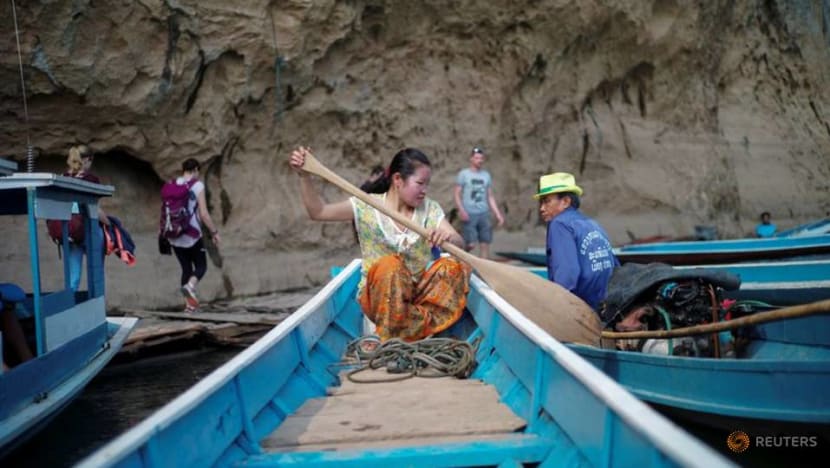Explainer: How hydropower dams can help ASEAN fight climate change

Hydropower construction in Laos has been halted due to fears of COVID-19 contagion. (Photo: Jack Board)
Dams are infrastructures built to control river flow and store large amounts of water in artificial lakes or reservoirs.
They are used not only for agricultural water supply and flood control, but also to produce electricity. The water released from dams flows through turbines, whose mechanical energy is converted into electricity by a generator.
Since the construction of the first dams in the late 19th century, thousands of hydroelectric stations have been built across the world. Southeast Asia is no exception, with the mighty Mekong, Irrawaddy and Chao Phraya among the river basins that have attracted the attention of the hydropower industry.
All these rivers are far from big cities such as Kuala Lumpur or Singapore, where the demand for electricity is high. So, why should we be interested in dams?

There are many reasons. First, the competitive advantage of hydropower over fossil fuels is that its carbon footprint is small, almost zero. This means hydroelectricity could help us replace, at least partially, gas, coal and oil, on which many countries rely.
Moreover, dams last for decades and have lower operating costs, since water, the source of energy, is free. And, where big rivers meet steep gorges, a lot of electricity is generated.
For example, Laos has dozens of hydropower plants, with a total installed hydropower capacity of about 7 GW. That is roughly half of Singapore’s total electricity generation capacity.
But to ensure these benefits are realised, we must be able to ‘move’, or transmit hydroelectricity from the big rivers to the big cities. Such a service may be provided by the ASEAN (Association of Southeast Asian Nations) Power Grid, a large infrastructure conceived to interconnect all ASEAN countries. This power grid, first mooted in the 1990s, is still work in progress.
While the entire infrastructure may take years to be planned and realised, we already have tangible proof of its potential. For instance, Malaysia has signed a three-party energy deal with Thailand and Laos, according to which Malaysia will buy hydropower from Laos via Thailand.
Singapore has recently announced that it plans to import electricity from Malaysia, starting with a two-year trial. The city state will also be part of a power integration project together with Laos, Thailand and Malaysia. This power integration project is known as a “pathfinder” to the broader ASEAN Power Grid.
READ: Commentary - Importing electricity from Malaysia is a good thing
There are more ways in which hydropower helps us reduce carbon dioxide emissions: dams complement the power production of other renewables, such as solar and wind energy, whose power output is intermittent.
As large batteries are still not cost-effective, power utilities use dams to store water and, therefore, power. In other words, utilities can decrease hydropower production when the sun is shining, or when the wind is blowing, and then increase it when needed. By integrating all these resources, we have a pathway for reducing the carbon footprint of the electricity sector.
IS THE CONSTRUCTION OF DAMS ALWAYS GOOD NEWS?
Unfortunately, the answer is no.
Just as much as they are powerful in harnessing renewable energy, dams also negatively impact the environment. They disconnect river segments, thereby limiting, and sometimes stopping, the flow of sediment and nutrients, the lifeblood of rivers. They also obstruct fish migration and alter the natural hydrological regimes.
In some cases, water reservoirs permanently flood large areas that are home to bio-diversity hotspots and native communities.
In other words, there is a hidden price that both environment and society pay for hydroelectricity. It is therefore not surprising that many organisations advocate against the construction of new dams.

A clear example is given by Xayaburi dam, a 1.4 GW hydropower project recently completed in Northern Laos.
It is not only its sheer size that raised concerns, but also the fact that this is the first dam built by Laos on the mainstream Mekong. This means the dam has a deeper impact on the river ecosystem and its fisheries.
More dams on the mainstream would therefore cause irreparable damages to the river and the socio-economic systems it supports.
READ: Southeast Asia’s hydropower boom grinds to a halt as COVID-19 stalls projects
WHERE DO WE GO FROM HERE?
Reducing carbon dioxide emissions from the power sector is a fundamental step towards fighting climate change, so we may expect that hydropower will keep playing an important role in the coming years, together with solar, wind and other renewables.
And as more ASEAN countries collaborate on energy agreements — and the ASEAN Power Grid becomes fully realised — demand centres and major cities will be connected to more production sites, hopefully reducing pressure on river basins.

Thailand, for example, is not only importing hydropower from Laos, but also increasing its share of renewable energy. If all goes as planned, the renewable energy quota will be increased to about 30 per cent by 2037. This means big cities, such as Bangkok, can rely less on imported hydropower and more on solar, wind, and biomass.
The future of power supply in Southeast Asia may be greener if we stop, or limit, the construction of new dams, and instead focus on diversifying the renewable generation mix and trading clean energy across countries.
Stefano Galelli is an Associate Professor at the Singapore University of Technology and Design, where he leads the Resilient Water Systems Group.














